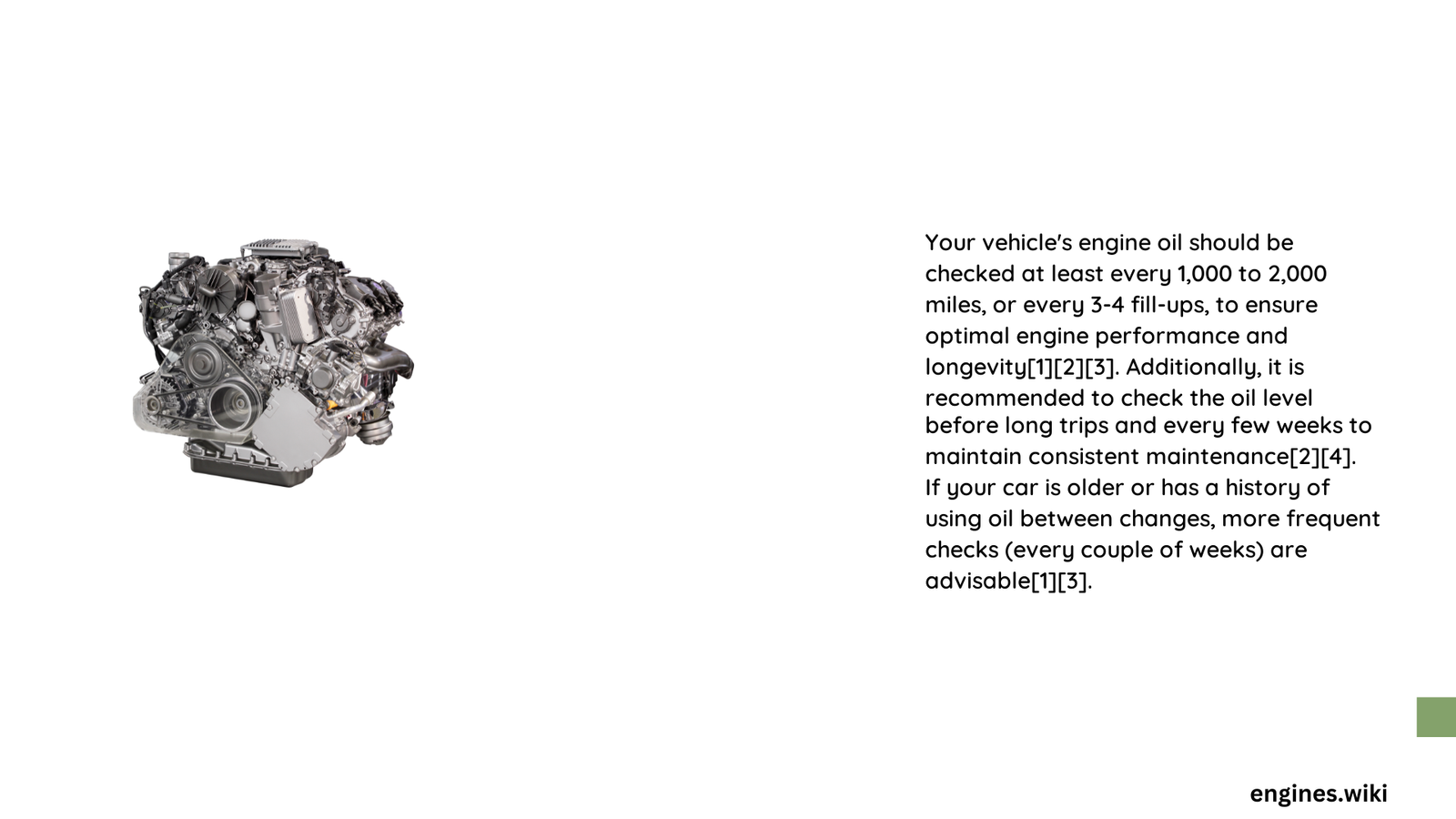Vehicle engine oil is the lifeblood of your car’s performance, and understanding how frequently you should check it can prevent costly damage and extend your engine’s life. Regular oil checks are crucial for maintaining optimal engine health, preventing wear, and ensuring smooth vehicle operation across various driving conditions and vehicle types.\n\n## What Determines the Frequency of Engine Oil Checks?\n\nChecking your vehicle’s engine oil is not a one-size-fits-all task. Multiple factors influence how often you should inspect your oil levels and condition:\n\n### Why Does Driving Condition Matter?\n\nDriving conditions play a significant role in determining oil check frequency:\n\n- Urban Stop-and-Go Driving: More frequent checks recommended\n- Highway Driving: Less frequent checks typically sufficient\n- Extreme Temperature Regions: Increased monitoring required\n\n| Driving Condition | Recommended Check Frequency |\n|——————|—————————–|\n| Normal Conditions | Every 1,000 miles or monthly |\n| Extreme Conditions | Every 500-750 miles |\n| High-Performance Vehicles | Every 500 miles |\n\n### How Do Vehicle Age and Mileage Impact Oil Checks?\n\nVehicle age significantly influences oil maintenance requirements:\n\n1. New Vehicles (0-3 years)\n – More stable oil consumption\n – Check every 1,000-1,500 miles\n\n2. Older Vehicles (4-10 years)\n – Higher potential for oil leaks\n – Check every 500-1,000 miles\n\n3. High-Mileage Vehicles (10+ years)\n – Most frequent checks required\n – Inspect every 300-500 miles\n\n### What Are the Warning Signs of Low Engine Oil?\n\nRecognizing potential oil-related issues is crucial for preventive maintenance:\n\n- Unusual Engine Noises: Knocking or ticking sounds\n- Dashboard Warning Lights: Oil pressure indicators\n- Visible Oil Leaks: Spots underneath the vehicle\n- Burnt Oil Smell: Indicates potential overheating\n\n## Best Practices for Engine Oil Maintenance\n\nTo ensure optimal engine performance, follow these professional recommendations:\n\n- Use high-quality oil appropriate for your vehicle\n- Keep a consistent maintenance schedule\n- Use digital or physical tracking methods\n- Invest in regular professional inspections\n\n### How to Perform a Proper Oil Check?\n\n1. Park on a level surface\n2. Ensure engine is cool or slightly warm\n3. Locate the dipstick\n4. Pull out and wipe clean\n5. Reinsert and check oil level\n6. Observe color and consistency\n\n## Technical Insights for Oil Maintenance\n\nModern vehicles often come equipped with advanced oil monitoring systems that can provide real-time data about oil condition and recommended check intervals. However, these systems should complement, not replace, manual checks.\n\n### What Oil Type Influences Check Frequency?\n\n- Conventional Oil: More frequent checks\n- Synthetic Oil: Extended check intervals\n- Synthetic Blend: Moderate maintenance requirements\n\n## Conclusion\n\nRegular engine oil checks are a critical aspect of vehicle maintenance. By understanding your specific driving conditions, vehicle age, and manufacturer recommendations, you can develop an effective oil monitoring strategy that preserves your engine’s longevity and performance.\n\n### Reference:\n- Society of Automotive Engineers\n- National Institute for Automotive Service Excellence\n- Car Maintenance Experts

